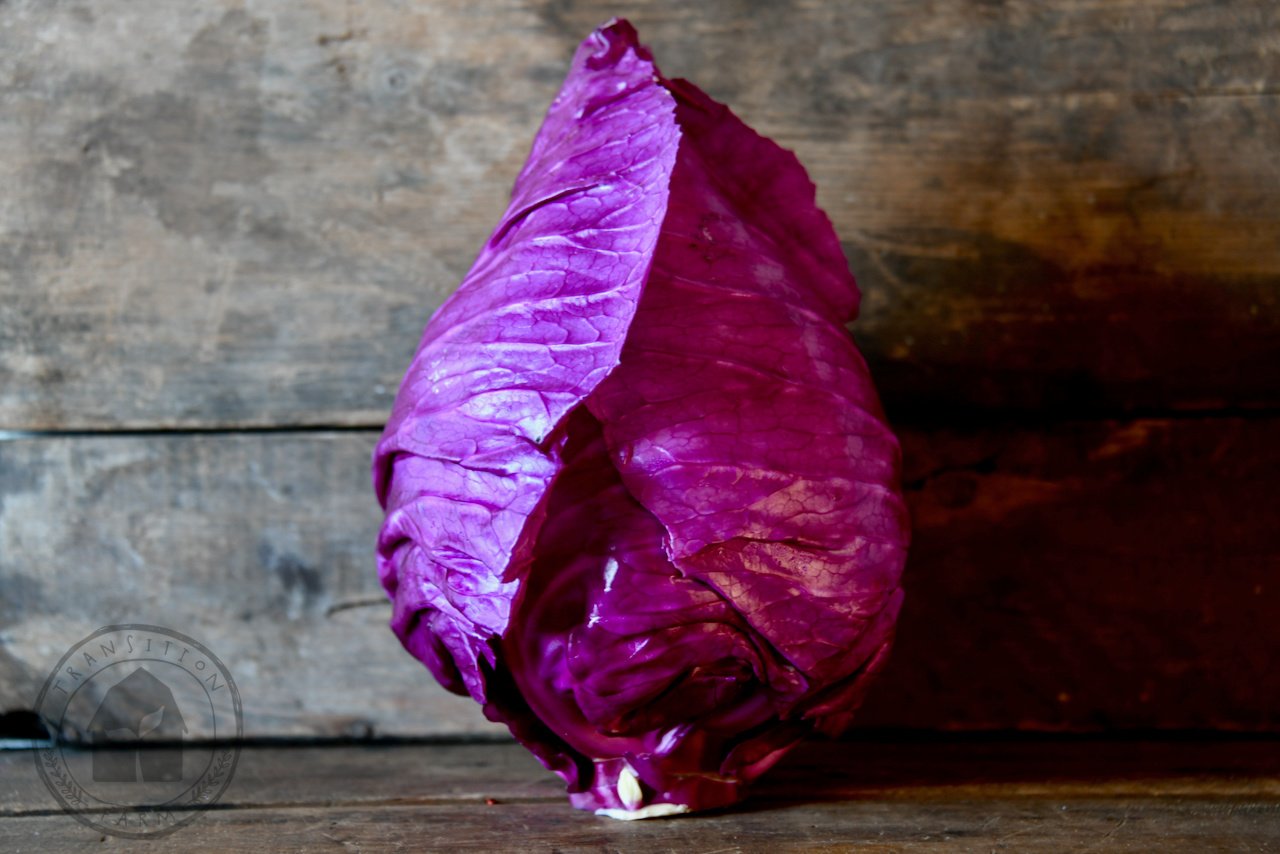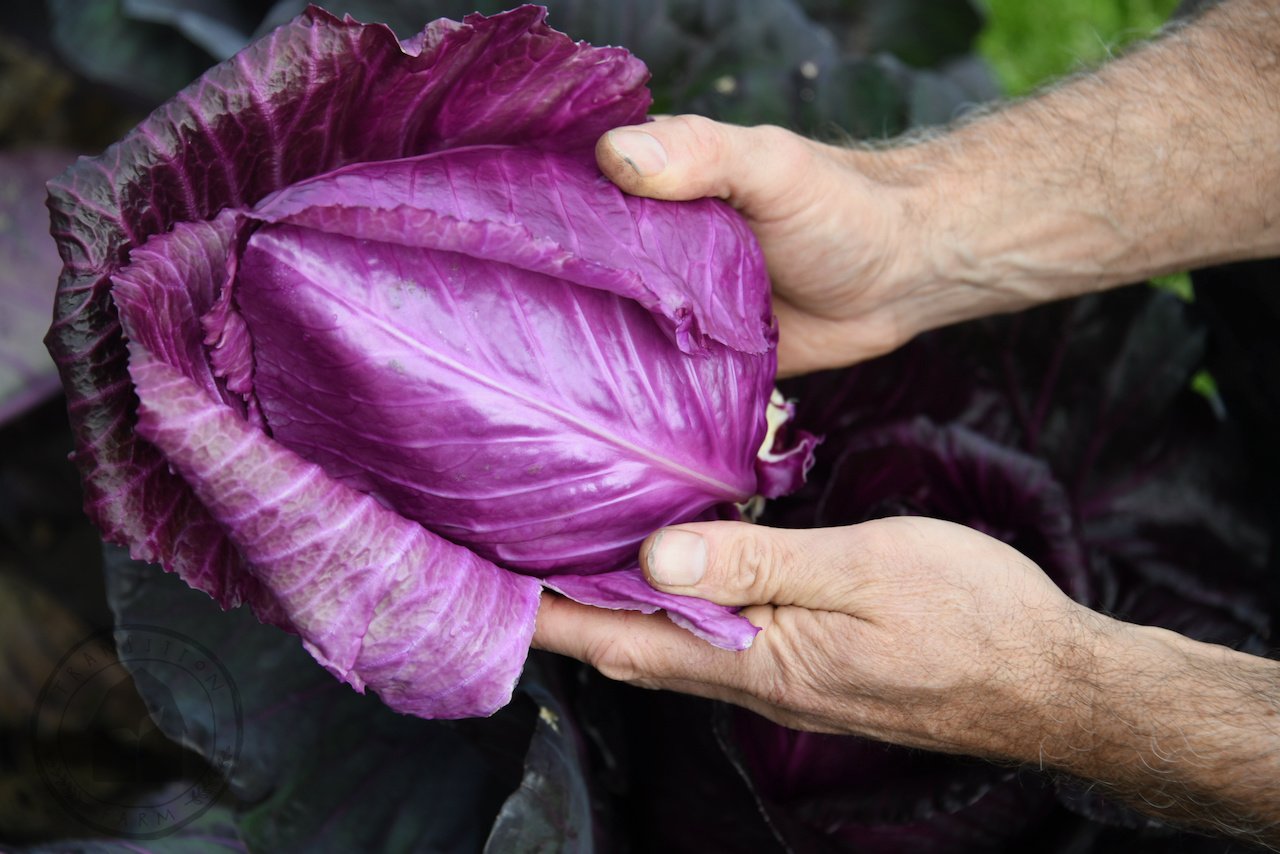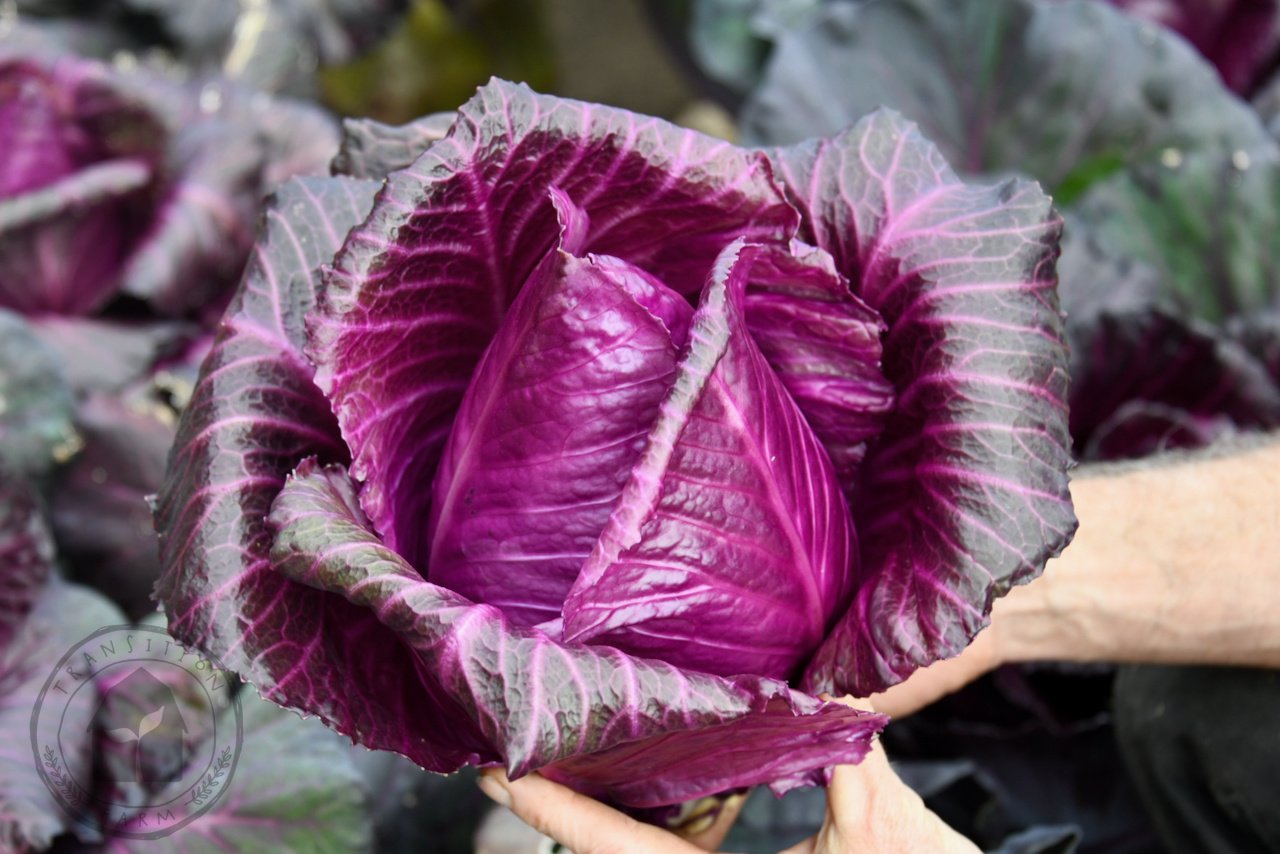Every Seed Has A Story - 'Kalibos' Cabbage
/Every seed has a story. It could trace back centuries, having a rich history of supporting civilisations. Or it could be a recent selection that may take the market by storm…and become the legacy of the breeder.
That rich story enhanced our variety selection early on as market growers. We LOVE food and built the foundations of Transition Farm on food with flavour. Our biodynamic growing practices added depth in nutrients and taste to everything we grew. We also realised that some varieties intrinsically offer a flavour, colour, texture that is so unique - they have the potential to raise a meal - something worth talking about and celebrating - something unforgettable.
As seed stewards, preserving the qualities of each variety we cultivate, be it a flower, herb or vegetable, is at the core of our work. We invite you to share in this story with us
‘Kalibos’ Cabbage
We first discovered ‘Kalibos’ Cabbage in the Baker Creek seed catalogue in 2008. We were intrigued by the colour, a glowing magenta, conical shaped head surrounded by darker red/purple outer leaves with hot pink veins. It is a stunning plant that brings the winter garden a contrast and sublime beauty. Grown in autumn for winter harvesting, the flavour is sweet, juicy, and minerally - just as good cooked as it is as a slaw with lime juice and coriander. One of the strengths of this cabbage is its ability to hold in the field throughout winter. We are still harvesting 1.2-1.5k heads in the third week of August from a early February sowing.
‘Kalibos’ History
Baker Creek Seeds shares the story of ‘Kalibos’ in community gardens in Poland and Czechia. It was beloved as a winter crop. Breeders at the Institute for Botanical Research in the Northern Czechian city of Jablonic improved it as a sauerkraut cabbage. In 1998, they registered the improved variety, giving it the name ‘Kalibos’.
We grew it for several years in our home garden both in the early spring and in the summer for autumn/winter harvest. The maturity was between 85-110 days which worked in the home garden and we loved how well the heads held through winter. Not all the plants produced a head though, and sometimes the heads produced were not the intense magenta colour nor conical in shape.
When we were growing for 125 families and producing a vegetable box each week, we wanted to include a small frame, tasty cabbage. We spoke with a seed rep about the variable maturity rate and inconsistencies we found with ‘Kalibos’. He suggested a hybrid red cabbage called ‘Tinty F1’. His selling points were a faster, more uniform maturity rate and reliable heads.
‘Tinty’ not only lacked the colour and flavour profile of ‘Kalibos’, but also produced a “reliable” head in the middle of the planting but the edges were struggling. As a whole crop, what we observed was a variety that did not know how to make use of our humus rich, biologically active soil.
We have had many “aha” moments since using the Australian Demeter Biodynamic method. Growing ‘Tinty’ was one of them. When we compared the crop produced from this commercial grade, conventionally produced seed to that produced using a commercial grade, organic seed, we began to understand how organic seed can work for organic growers. Seed that carries the genetics for building a robust root system that can network and thrive in biologically active, low input soil not only provides a more nutrient dense product, it also provides more harvest security using fewer inputs. What we were seeing with ‘Tinty’ was a crop that had been conditioned to need fertiliser.
Seed Genetics - Breeding Goals
In 2018, we re-discovered ‘Kalibos’ with organic seed that had been stewarded for several seasons by Fruition Seeds in the Finger Lakes region of New York. The story they shared offered great insight into not only the ability of selective breeding to restore variety genetics but also how the network of seed can work.
Fruition Seed worked with local biodynamic farmers, Robin & Lou of Blue Heron Farm, who loved ‘Kalibos’ cabbage and had been ‘witnessing the erosion of this OP seed over the years.” As Petra from Fruition Seed writes,
“By the time they asked us to collaborate on restoring Kalibos, less than 10% of her heads were cone-shaped and the brilliant purple was evident in no more than 80% of the population, though all were lusciously tender & remarkably sweet.”
Blue Heron Farm grew 2000 heads of ‘Kalibos’ each season. At maturity, Fruition Seed crew went through the field and marked plants that met the following breeding goals:
Early maturity
Strong cone shaped, dense heads
Rich magenta colouring
Large head to leaf ratio
These heads were then regrown in the spring as an organic seed crop. The seed we used from Fruition Seed was in its fourth generation - They had grown that seed out and produced seed four times, continually selecting only those heads that fit their variety description and breeding goals!
Using Fruition seed, we re-ignited our love affair with ‘Kalibos’ by first growing our own seed crop. We had already come to realise that relying on imported seed was fraught with many issues - the main one being that Australia is a very different region to anywhere else. By regionalising the seed not only to our area, winter and sunlight but also to our biodynamic soil and management, we were building a more resilient seed for us. We used the breeding goals set out by Frution Seed as the basis for our own breeding goals.
We marked plants that met the following criteria:
Heads ready for harvest within 85-90 days of being transplanted
Conical shaped, dense heads
Magenta coloured inner head, surrounded by deep red/purple outer leaves with fuchsia veins
Large head to leaf ratio (which allows for a tighter spacing)
Plants showed no sign of disease
These plants were marked and held in the field through winter and then we further selected:
Those plants that did not crack nor bolt early
Heads that held well through multiple frosts
Sweet flavour with a diverse mineral palette
Robin Further evaluating the plants that will go through to seed production
Seed Production - Crop Resilience
Cabbage is in the Brassicacae family - it is a Brassica oleracea and is pollinated by insects. Because they are insect pollinated, Brassica oleracea requires 250-800m of distance between each variety that is in flower. On our size farm in the open field, we can only grow ONE cabbage, broccoli, kale, brussel sprout, cauliflower, collard green OR kol rabi - different crops but all capable of cross pollinating - for seed production each season.
Viable seed can be produced by 5 plants but we choose a population of 80+ plants to preserve the genetics of the crop. The more diverse the parentage - even while displaying similar characteristics, the more resilience that can be found when something new comes along - such as a new climate stress or disease. By working with a diverse gene pool over many seasons, we have the chance to continually improve on and modify our breeding goals, while still maintaining a rich genetic history that helps provide resilience. These large, diverse plant populations can grow into landraces - continually offering selective breeding opportunities to further the genetic history..
Our ‘Kalibos’ will go to seed again this season hopefully producing a 3rd generation, regionalised, Demeter certified biodynamic seed. We are still seeing a 5% rate of plants that do not produce a dense head. This is an improvement on 15% in our first season. The rich genetic history that makes this crop resilient also invites it to express all of its variations. While modern agriculture has lured farmers with the idea that a consistent mono crop has a higher production rate and thus a higher profit margin, we and many others in agriculture are questioning —at what cost?
The loss of genetic diversity includes no buffer for nor ability to adapt to changes in disease and pest pressure and climate variability. Pests are moving, new diseases are appearing, extreme weather events are becoming more frequent. Growers need seed with resilience in bred. With some of the seed we are stewarding moving into 4th and 5th generation biodynamic, regionalised seed, we are seeing more resilience in the plants.
But growers also need assurance that their field space is not wasted. While we embrace the genetic richness offered by a large population, we are also rigorous in our selection, continually trying to shore up the genetics of the variety. In the case of ‘Kalibos’, it is not just head shape, density and colouring that are important to a market grower. The large head to leaf ratio and the ability of the crop to thrive in low input growing conditions provides for a closer spacing offering a higher yield per square metre. Currently spaced at 18inches, 2 rows per 30inch bed, ‘Kalibos, produces dense heads that are 1.2 - 1.5 kilos.
Seed Networks
A thriving seed network includes the seed stewards, the seed sellers, the farmers and growers, AND the eaters. Wendall Berry, a farmer and writer, eloquently drew the circle of plant life from a seed to its harvest to its consumption.
“Eating is an agricultural act. Eating ends the annual drama of the food economy that begins with planting and birth.”
‘Kalibos’ cabbage has drawn so many seed stewards and farmers to continue adding the human component of selective breeding, open pollinated varieties and producing regionalised, resilient seeds because it is a delight to eat! The colour and flavour are superb - and it has a range of applications making it versatile in the kitchen. Add to that it’s ability to add a multitude of nutrients - including large amounts of Vit C and protein to our winter diet, ‘Kalibos’ offers so much.
Every seed has a rich story. ‘Kalibos’ seed’s story stretches across continents, fields and kitchens. It shows the great network of food security - seed breeders, seed growers, farmers and eaters all connected! ‘Kalibos’ has been steward for many decades - and we hope that it’s legacy will continue - because it is a nutritious, beautiful food that communities of eaters love. It is also in our Southern Victoria coastal climate, a great winter crop that we feel holds its own in the market garden.
Growing Information
‘Kalibos’ cabbage grows most sweet & tender in cool temperatures with biologically rich soil. Precede the crop with a green manure crop for optimum head growth.
Start seed in mid July for harvest in mid November OR January - Early February for autumn and over-wintering harvests
Transplant (recommended) - Sow 2 seeds per cell - thinning to one. Grow with strong light and gentle breeze. Transplant at 4-5 weeks old.
Spacing - 45cm between plants and 45–90cm between rows.
Pests - Use netted row cover to protect from Cabbage Moth and Diamond Back Moth
Recipe Suggestions
Slaw with a dash of olive oil, 2 cloves of garlic, LOTS of chopped coriander, juice of 2 limes, lime zest, salt, white pepper and rice vinegar to taste - perfect with black beans and rice
Read More
“We are all plant breeders now” by Petra Page-Mann of Fruition Seed
“Kalibos cabbage - Beautiful for Sauerkraut” by Baker’s Creek
























